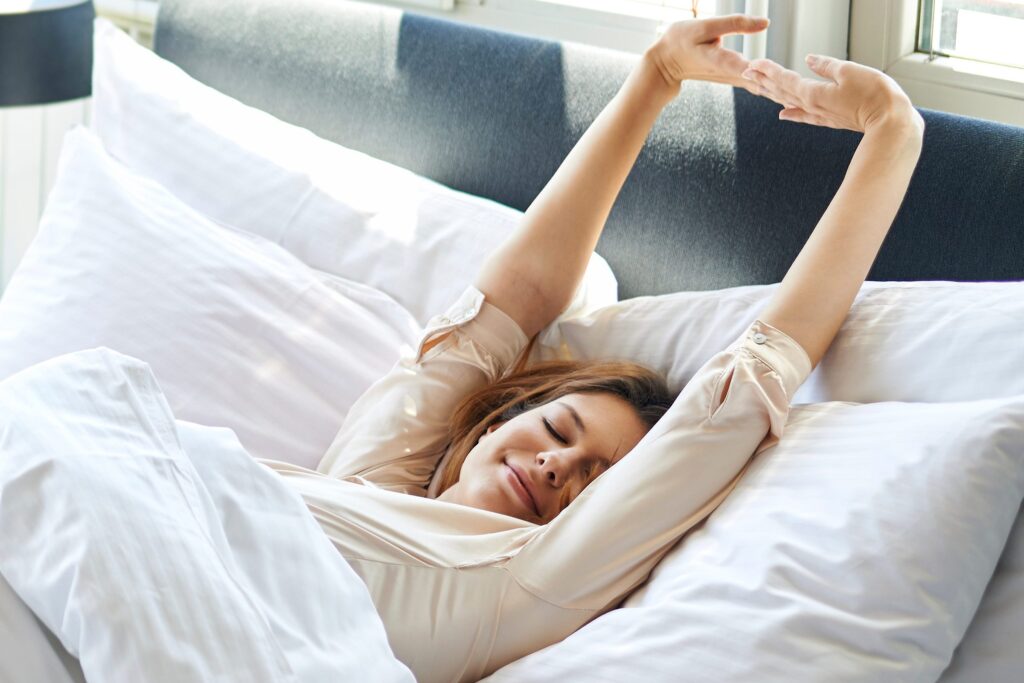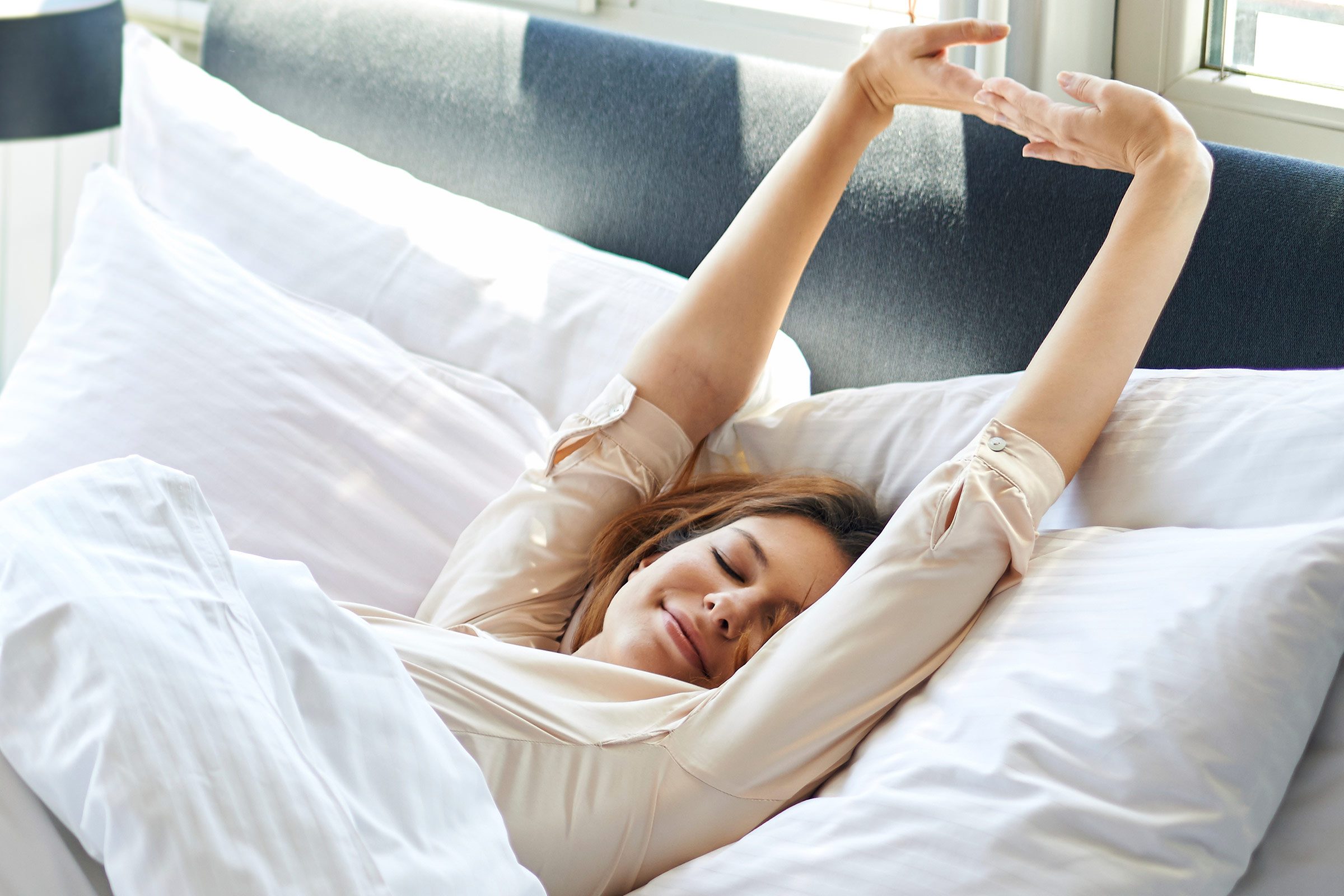Getting a good night’s sleep is crucial for both physical and mental health. When you’re tired, it’s essential to unwind before going to bed to ensure you’re well-rested for the next day. Establishing a calming bedtime routine can significantly improve the quality of your sleep.

A consistent sleep schedule and a relaxing pre-sleep routine can help signal to your body that it’s time to sleep. This can include a variety of relaxation tips such as reading, meditation, or a warm bath. By incorporating these sleep tips into your nightly routine, you can enhance your sleep quality and wake up feeling refreshed.
Key Takeaways
- Establish a consistent sleep schedule to improve sleep quality.
- Incorporate relaxing activities into your bedtime routine.
- Avoid stimulating activities before bedtime.
- Create a sleep-conducive environment.
- Limit exposure to screens before sleeping.
The Sleep Crisis in America
The United States is grappling with a significant sleep crisis. This issue affects not only the individual’s health but also has broader societal implications.
Current Sleep Statistics in the USA
Sleep statistics in the USA reveal a concerning trend. According to recent studies, over 30% of the general population experiences sleep disruption.
| Sleep Duration | Percentage of Population |
|---|---|
| Less than 6 hours | 35% |
| 6-8 hours | 55% |
| More than 8 hours | 10% |
How Poor Sleep Affects Daily Performance
Poor sleep significantly impacts daily performance. As
“Sleep is essential for cognitive function, emotional regulation, and physical health.”
noted by sleep experts.
Sleep deprivation can lead to decreased productivity, increased risk of accidents, and a weakened immune system. Ensuring adequate sleep is crucial for overall well-being.
Understanding Your Body’s Sleep Needs
Sleep is a vital aspect of our daily lives, and grasping its mechanisms can significantly enhance our well-being. Understanding how our bodies function during sleep can help us identify ways to improve the quality of our rest.
The Science of Sleep Cycles
Our sleep is divided into cycles, each consisting of different stages, including REM (Rapid Eye Movement) and non-REM sleep. REM sleep is crucial for mental restoration, while non-REM sleep is important for physical recovery. A full sleep cycle typically lasts around 90 minutes and repeats multiple times throughout the night.
During REM sleep, our brains process and consolidate memories, and our heart rate and blood pressure increase. In contrast, non-REM sleep is characterized by slower brain waves and is essential for repairing and regenerating tissues.
How Much Sleep Do Americans Really Need?
The amount of sleep needed varies across different age groups. Adults typically require 7-9 hours of sleep per night, while teenagers need 8-10 hours, and younger children need even more. Despite these recommendations, many Americans fail to get adequate sleep, leading to sleep deprivation and related health issues.
Understanding our individual sleep needs is crucial for maintaining good health. By recognizing the importance of sleep duration and quality, we can take steps to improve our sleep hygiene and overall well-being.
Why Relaxation Before Bed Is Critical
The importance of unwinding before bed cannot be overstated for overall sleep health. Relaxation is not just a precursor to sleep; it’s a fundamental component that ensures the quality of rest. As we transition from wakefulness to sleep, our body undergoes various physiological changes that are crucial for restorative sleep.
The Physiological Transition to Sleep
As we relax, our body begins to shift from a state of alertness to a state of calm, characterized by a decrease in heart rate, blood pressure, and body temperature. This transition is facilitated by the release of hormones such as melatonin, which promotes sleepiness. A relaxed state allows for a smoother transition into the different stages of sleep, including REM and non-REM sleep, which are essential for physical and mental rejuvenation.
How Stress Impacts Your Sleep Quality
Stress is a significant barrier to achieving quality sleep. When we’re under stress, our body’s “fight or flight” response is triggered, releasing stress hormones like cortisol. Elevated cortisol levels can interfere with the body’s natural sleep-wake cycle, making it difficult to fall asleep or stay asleep. Chronic stress can lead to long-term sleep disturbances, underscoring the importance of managing stress as part of a bedtime relaxation routine.
“Stress is the trash of modern life – we all generate it, but if you don’t dispose of it properly, it will pile up and become a burden.” – Unknown
Effective relaxation techniques before bed can mitigate the negative impacts of stress on sleep, promoting a restful and rejuvenating sleep experience.
Essential Relaxation Tips Before Sleeping
Creating a conducive sleep environment and practicing relaxation techniques can significantly improve sleep quality. As we navigate the demands of daily life, it’s crucial to prioritize relaxation before bed to ensure a restful night’s sleep.
The Science Behind Pre-Sleep Relaxation
Pre-sleep relaxation is more than just a calming activity; it’s a critical process that prepares our bodies for sleep. By engaging in relaxation techniques, we can lower our heart rate, reduce stress hormones, and calm our minds, making it easier to fall asleep. Techniques such as deep breathing, progressive muscle relaxation, and mindfulness meditation have been shown to be effective in promoting relaxation.
Creating Your Ideal Sleep Environment
A sleep-conducive environment is vital for improving sleep quality. Two critical factors in creating this environment are bedroom temperature and lighting.
Optimal Bedroom Temperature for Americans
The ideal bedroom temperature for sleep is between 60°F and 67°F. Sleeping in a room that’s too hot or too cold can disrupt sleep patterns. Maintaining an optimal temperature helps regulate the body’s natural sleep-wake cycle.
Lighting Considerations for Better Sleep
Lighting plays a significant role in our sleep-wake cycle. Exposure to bright lights before bed can suppress melatonin production, making it harder to fall asleep. Using dim red lights or nightlights can help minimize disruption. Additionally, ensuring the bedroom is dark can be achieved by using blackout curtains or blinds.
By implementing these relaxation tips and optimizing the sleep environment, individuals can significantly enhance their sleep quality, leading to better rest and overall well-being.
1. Establish a Consistent Bedtime Routine
Developing a bedtime routine can be a game-changer for those struggling with sleep. A consistent routine helps signal to your brain that it’s time to sleep, making it easier to fall asleep and stay asleep.
Components of an Effective American Bedtime Ritual
An effective bedtime ritual involves activities that promote relaxation and help your body transition to sleep mode. This can include reading, meditation, or a warm bath.
- Relaxing activities
- Calming environment
- Consistent timing
Sample 30-Minute Routine
A sample 30-minute routine could involve 10 minutes of deep breathing, 10 minutes of reading, and 10 minutes of journaling.
Consistency Tips for Shift Workers
For shift workers, maintaining a consistent bedtime routine can be challenging. However, using blackout curtains, earplugs, and a consistent sleep schedule can help.
How Routine Signals Your Brain for Sleep
A consistent bedtime routine signals your brain that it’s time to sleep by creating a pattern of behavior that your brain associates with sleep.
| Activity | Duration | Benefits |
|---|---|---|
| Deep Breathing | 10 minutes | Relaxation, reduced stress |
| Reading | 10 minutes | Distraction from daily stress, relaxation |
| Journaling | 10 minutes | Reflection, stress relief |
By incorporating these activities into your bedtime routine, you can improve the quality of your sleep and wake up feeling refreshed.
2. Practice Mindful Meditation and Deep Breathing
Incorporating mindful meditation and deep breathing into your bedtime routine can significantly enhance sleep quality. These practices help calm the mind and body, making it easier to fall asleep and stay asleep throughout the night.
Beginner-Friendly Meditation Techniques
For those new to meditation, starting with simple techniques can make a big difference. Here are a few methods to begin with:
- Focused Attention: Concentrate on your breath or a mantra to quiet your mind.
- Open Monitoring: Observe your thoughts and feelings without judgment.
The 4-7-8 Breathing Method
The 4-7-8 breathing technique, also known as the “Relaxation Breath,” involves breathing in through the nose for a count of 4, holding the breath for 7, and exhaling through the mouth for 8. This can help slow down your heart rate and induce relaxation.
Body Scan Meditation for Sleep
Body scan meditation involves lying down or sitting comfortably and bringing awareness to different parts of your body, starting from your toes and moving up to your head. This practice helps release physical tension and promotes relaxation.

Popular Meditation Apps in America
Several meditation apps have gained popularity in America for their guided meditations and user-friendly interfaces. Some of the top apps include:
- Headspace: Known for its personalized meditation sessions.
- Calm: Offers guided meditations and sleep stories.
- Insight Timer: Features a wide range of free meditations and a timer for personal practice.
These apps can be a great resource for beginners and experienced meditators alike, providing structured programs to improve sleep quality.
3. Take a Warm Bath or Shower
Incorporating a warm bath or shower into your bedtime routine can significantly improve sleep quality. This relaxing activity helps to calm the mind and body, preparing you for a restful night’s sleep.
Temperature Regulation and Sleep Science
Our body’s temperature plays a crucial role in regulating sleep. A warm bath or shower can help to raise the body’s temperature, and the subsequent cooling down can promote a deeper sleep. This process is linked to the body’s natural temperature regulation cycle, where a cooler body temperature is associated with better sleep quality.
The science behind this involves the hypothalamus, the part of the brain that regulates body temperature. When you take a warm bath or shower, the hypothalamus works to cool the body down after the bath, leading to a state of relaxation and sleepiness.
Enhancing Your Bath with Sleep-Promoting Elements
To further enhance the sleep-promoting effects of a warm bath or shower, you can incorporate various elements. Essential oils such as lavender and chamomile are known for their calming properties and can be added to the bath water.
Additionally, Epsom salts can be used to relax the muscles and promote a sense of calm. The magnesium in Epsom salts can help to reduce inflammation and improve sleep quality.
Best Bath Products for Sleep in the US Market
Some popular bath products that can promote sleep include:
| Product | Key Ingredients | Benefits |
|---|---|---|
| Lavender Dream Bath Salts | Lavender oil, Epsom salts | Promotes relaxation, reduces stress |
| Calming Bath Bombs | Chamomile extract, lavender oil | Soothes the mind and body |
| Magnesium Rich Bath Salts | Magnesium chloride, lavender oil | Relaxes muscles, promotes better sleep |
Ideal Timing for Pre-Sleep Bathing
The ideal time to take a warm bath or shower is about 90 minutes before bedtime. This allows the body to cool down and relax, making it easier to fall asleep.
Taking a warm bath or shower at the right time can be a valuable addition to your bedtime routine, promoting a restful and rejuvenating sleep.
4. Read a Physical Book
As the day comes to a close, picking up a physical book can be a calming way to signal to your brain that it’s time to wind down. In an era dominated by digital screens, the simple act of reading a physical book before bed can be a powerful tool for improving sleep quality.
Unlike digital devices, physical books do not emit the sleep-disrupting blue light that can trick the brain into thinking it’s still daytime. Moreover, the tactile experience of holding a book, turning pages, and immersing oneself in a story can be incredibly soothing.
Why Digital Screens Disrupt Sleep Patterns
Digital screens, including those on smartphones, tablets, and e-readers, emit blue light that can suppress the production of melatonin, the hormone responsible for regulating sleep. Exposure to blue light in the evening can trick the brain into thinking it’s still daytime, making it harder to fall asleep.
Studies have shown that reading on a digital device before bed can lead to poorer sleep quality and reduced melatonin production compared to reading a physical book. This is because digital screens often have backlighting that emits blue light, which can disrupt the body’s natural sleep-wake cycle.
Selecting Sleep-Friendly Reading Material
Not all reading material is created equal when it comes to promoting sleep. Choosing the right type of book can make a significant difference in how relaxing the experience is.
Most Relaxing Book Genres Before Bed
Some book genres are more conducive to sleep than others. For example:
- Fiction novels with engaging storylines can distract from the stresses of the day.
- Poetry can be calming and meditative.
- Non-fiction books on topics like history or science can be informative without being too stimulating.
Reading Posture and Lighting Tips
To maximize the sleep-promoting benefits of reading, it’s essential to consider reading posture and lighting. Reading in a comfortable position can help relax the body, while soft, warm lighting can create a cozy atmosphere.
| Reading Tip | Description | Benefit |
|---|---|---|
| Comfortable Position | Read in a cozy chair or bed | Relaxes the body |
| Soft Lighting | Use table lamps or floor lamps | Creates a calming ambiance |
| Avoid Bright Lights | Dim or turn off overhead lights | Reduces eye strain |
By choosing the right reading material, adopting a comfortable reading posture, and using appropriate lighting, reading a physical book can become a valuable part of a bedtime routine that promotes relaxation and improves sleep quality.
5. Listen to Calming Sounds or Music
Incorporating calming sounds or music into your bedtime routine can significantly enhance your sleep experience. This method is not only simple but also highly effective in creating a relaxing atmosphere that signals to your brain that it’s time to sleep.
The Science of Sound and Sleep
Research has shown that listening to calming sounds or music can have a profound impact on sleep quality. The brain responds to soothing sounds by reducing stress and anxiety, making it easier to fall into a deep sleep. “The use of sound therapy has been shown to improve sleep quality by reducing the time it takes to fall asleep and increasing the duration of deep sleep,” according to a study published in the Journal of Sleep Research.
The science behind this phenomenon lies in the brain’s response to different frequencies and volumes. Calming sounds, such as rain or ocean waves, can help mask background noises that might disrupt sleep. Moreover, the consistent rhythm of these sounds can be hypnotic, further aiding in relaxation.
Creating Your Perfect Sleep Soundtrack
Creating a sleep-conducive soundtrack involves selecting sounds or music that are calming and consistent. Nature sounds, such as rain or forest noises, are popular choices. Some people also prefer white noise or the sound of a gentle breeze. The key is to find what works best for you and incorporate it into your bedtime routine.
Experimenting with different types of music or sounds can help you identify your ideal sleep soundtrack. You might find that instrumental music or ambient sounds are more effective for you than nature sounds.
Popular Sleep Sound Apps and Services in the US
There are numerous apps and services available that offer sleep soundtracks. Some of the most popular include Calm, Rainy Mood, and SimplyNoise. These platforms provide a wide range of sounds and music designed to help you relax and fall asleep.
Headphones vs. Speakers for Sleep Audio
When it comes to listening to sleep sounds, the choice between headphones and speakers depends on personal preference. Headphones can be more effective at blocking out external noise, while speakers can create a more immersive environment. Some people prefer to use a combination of both, depending on their sleeping position and comfort level.

As Andrew Weil, MD, a renowned expert in sleep and relaxation, once said, “The key to a good night’s sleep is creating a sleep-conducive environment, and sound is a critical component of that environment.” By incorporating calming sounds or music into your bedtime routine, you can significantly improve your sleep quality and wake up feeling refreshed and rejuvenated.
Sleep-Promoting Products Popular in America
The quest for better sleep has driven Americans to explore various sleep-promoting products. These products range from natural sleep aids and supplements to advanced tech gadgets designed to enhance sleep quality.
Natural sleep aids have gained popularity due to their perceived safety and efficacy. Products containing melatonin, valerian root, and lavender are commonly used to promote relaxation and improve sleep.
Natural Sleep Aids and Supplements
Many Americans prefer natural sleep aids as an alternative to prescription sleep medications. Some of the most popular natural sleep aids include:
- Melatonin supplements to regulate sleep-wake cycles
- Valerian root capsules to promote relaxation
- Lavender essential oils for calming effects
| Product | Benefits | Form |
|---|---|---|
| Melatonin | Regulates sleep-wake cycle | Tablets/Capsules |
| Valerian Root | Promotes relaxation | Capsules/Essential Oil |
| Lavender | Calming effects | Essential Oil/Pillows |
Tech Gadgets for Better Sleep
Technology has also played a significant role in improving sleep. Various tech gadgets are designed to monitor and enhance sleep quality.
Some popular sleep tech gadgets include:
- Sleep trackers that monitor sleep patterns
- Smart mattresses that adjust firmness and temperature
- White noise machines to create a sleep-friendly environment
By incorporating these sleep-promoting products into their nightly routine, Americans can potentially improve their sleep quality and overall well-being.
Customizing Your Pre-Sleep Routine
Tailoring your bedtime routine to your specific needs can make a substantial difference in your sleep quality. A one-size-fits-all approach often falls short when it comes to achieving restful sleep. By customizing your pre-sleep activities, you can address specific challenges that hinder your ability to fall asleep or stay asleep throughout the night.
For Different Age Groups
Different age groups have unique sleep requirements. For instance, older adults may need to focus on routines that alleviate joint pain or manage conditions like insomnia. Children and teenagers, on the other hand, benefit from consistent bedtime stories or relaxing baths to signal that it’s time for sleep.
| Age Group | Recommended Pre-Sleep Activities |
|---|---|
| Children | Bedtime stories, relaxing baths |
| Teenagers | Meditation, reading |
| Older Adults | Gentle stretches, warm milk |
For Various Sleep Challenges
Customizing your pre-sleep routine can also help tackle specific sleep challenges. For example, individuals suffering from insomnia might benefit from relaxation techniques like deep breathing or progressive muscle relaxation. Those experiencing restless leg syndrome may find relief through gentle stretches or a warm bath before bed.
- For insomnia: Try relaxation techniques like deep breathing or progressive muscle relaxation.
- For restless leg syndrome: Gentle stretches or a warm bath can be beneficial.
- For stress: Engage in mindfulness meditation or listen to calming music.
Conclusion
Improving sleep quality is within reach by incorporating simple yet effective relaxation techniques into your bedtime routine. This guide has explored various methods to help you unwind and prepare your body for a restful night’s sleep, from establishing a consistent bedtime routine to listening to calming sounds or music.
A sleep tips summary highlights the importance of creating a sleep-conducive environment, practicing mindful meditation, and avoiding digital screens before bed. By implementing these relaxation techniques summary strategies, you can significantly enhance your sleep quality and wake up feeling refreshed and rejuvenated.
Experiment with the suggested activities to find what works best for you, and make adjustments as needed to customize your pre-sleep routine. By prioritizing relaxation and sleep, you can improve your overall well-being and tackle the day with energy and clarity.
FAQ
What are the best activities to do before bedtime to improve sleep quality?
Establishing a consistent bedtime routine, practicing mindful meditation and deep breathing, taking a warm bath or shower, reading a physical book, and listening to calming sounds or music are some of the best activities to improve sleep quality.
How does stress impact sleep quality?
Stress can negatively impact sleep quality by making it difficult to fall asleep and reducing the overall quality of sleep. Practicing relaxation techniques such as meditation and deep breathing can help mitigate the effects of stress on sleep.
What is the ideal bedroom temperature for sleep?
The ideal bedroom temperature for sleep is between 60-67 degrees Fahrenheit, which can help promote better sleep quality.
How can I create a sleep-conducive environment?
Creating a sleep-conducive environment involves ensuring the bedroom is dark, quiet, and at a comfortable temperature. Using blackout curtains, earplugs, or a white noise machine can help achieve this.
What are some popular sleep sound apps and services in the US?
Some popular sleep sound apps and services in the US include Calm, Rainy Mood, and Sleep Sounds, which offer a range of soothing sounds to help improve sleep quality.
Can reading before bed improve sleep quality?
Yes, reading a physical book before bed can help improve sleep quality by relaxing the mind and body, and reducing exposure to screens.
What are some natural sleep aids and supplements that can help improve sleep?
Some natural sleep aids and supplements that can help improve sleep include melatonin, valerian root, and magnesium, which can help regulate sleep patterns and promote relaxation.
How can I customize my pre-sleep routine for different age groups?
Customizing your pre-sleep routine for different age groups involves considering the unique needs and challenges of each age group, such as adjusting the routine for children or older adults.








